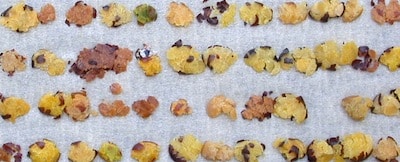November 30, 2016
Delivery points report a spike in heated canola. Growers are encouraged to check all canola bins as soon as possible. Spoilage usually starts small. Even with temperature cables, start points are not always detected until some of the grain is already damaged. Cooling the bin and stopping this early heating now can save a lot of money in lost grade and lost delivery options.
No.1 canola can have only 0.1% heated seed. See the CGC Grading Guide for canola.

Possible reasons for more heating are:
1) High moisture at binning and green plant material due to less-than-ideal separation, often as a result of harvest challenges due to cool temperatures, snow and rain increased many of these risk factors. (Top 10 risky situations for canola storage)
2) Canola harvested early and binned hot wasn’t given the attention it needed while the focus was on crop still out in the field for weeks and weeks.
3) Canola in bags. Bags likely do “breathe” more than bins and allow for greater temperature fluctuation based on ambient temperature, but they are not the “safer” option, especially for canola stored tough or damp in relatively mild temperatures.
What to do?
Check cables and look for temperatures not appropriately cool for the conditioning done. Any rise in temperature could be a sign, although spells of milder weather might mask what is really happening in the bin.
Transferring canola from one bin to another is the best way to detect heating. Hand probing through doors or roof hatches is unreliable for finding hot spots near the core of the bin. When transferring, move at least one third of the canola out of a bin. If green counts, moisture, weeds or dockage are high (in short, anything that may increase the storage risk), transferring the whole bin may be safest. Feel for heat and sniff for a burnt smell as the canola comes out of the bin.
If canola has started to spoil, start looking for delivery options. Many of the companies on this list will buy heated canola.
